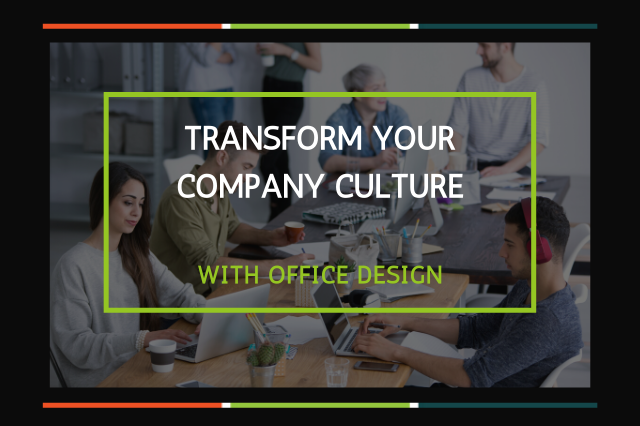
13 Jan Transform your Company Culture with Office Design
Company culture is a critical component of employee engagement, good collaboration and innovation, which ultimately affects a company’s bottom line.
Although many elements that make office culture aren’t tangible, research suggests that your architecture, interior design and fitout choices can support, or even transform, your organisational culture.
Unfortunately, many businesses treat their office spaces as a cost, rather than a potential driver for performance. They’re often judged through functional considerations, like increased density, office reductions, and convenient one-size-fits-all workstations without consideration for the productivity or efficiency of the employees working in them.
This is more than unfortunate, as a study from the Department of Economics at the University of Warwick showed, 12% more productive than the average worker, and unhappy workers are 10% less productive. Considering that 70% of the workforce is not engaged, and disaffected workers cost American businesses roughly $450 to $550 billion each year in lost productivity, having an engaging work company culture can help regain those lost returns.
Recognising space supports productivity and company goals are the first step to creating that engaging workplace that you wish. The next step is to identify what type of organisation you have in your company. Logically, different types of company cultures need different conditions that can consistently support their branding and personality.
The 3 major culture types
The University of Michigan defined the majority of company cultures can be grouped into three main types: Hierarchy, Clan, and Adhocracy.
Hierarchy Culture
Hierarchical culture is widely adopted by companies who aim to generate consistent, efficient and predictable output. Heirarchy company cultures are what the general public understand as more traditional, professional company cultures that have clearly defined authorities and departments that allow it to be easy to divvy responsibilities and roles. Often, authority, rules, standardisation and accountability are values
Clan Culture
Operating according to a set of shared values, Clan-cultured organisations lead to a base sense of community and teamwork. Work-environments in a clan cultured business hold a familial quality that directly opposes the clearly defined lines of a hierarchical office culture. Instead, managers strive to empower employees while simultaneously establishing their commitment to the company through cross-collaboration and employee involvement programs.
Adhocracy Culture
The most responsive company culture in the hyper turbulent, ever-accelerating conditions that increasingly typify the organisational world of this century. This type of office culture is founded in innovation and belief that pioneering initiatives that will lead to success. Therefore, management’s main objective is to foster entrepreneurship, creativity and activity amongst employees. Without a central authority or power relationships, teams are created from what problem is being assessed, with power flowing from whatever employee is most suited to the task.
Match your Office Design to Your Company Culture
Each company culture strives to promote a different kind of employee output – and therefore requires a distinctive office design that help facilitate that productivity and engagement. ‘
Fixed Environments are Great for Hierarchical Cultures
With all the internal procedures, standardisation and bureaucratic communication flows, it requires a completely different workspace layout than a place that strives to stimulate collaboration and innovation.
Office design specs that help hierarchical culture creating spaces that allow individuals to focus on tasks and meeting the deadlines distractions from surrounding peers. Fixed furniture can provide stability and security for the employees, giving each the private space that they can modify for their individual needs, tasks and personalities, increasing the capacity of individuals within a space.
Often, large official conference rooms, or break rooms, as these spaces may be the only areas in which employees come together to interact.

Teamwork Facilitators for the Clans
To support clan cultures, offices that are designed to support team building, flexibility and exhibit a concern for people are paramount. Workstations might limit the panels of their walls to limit the boundaries that cubicles represent, and more collaborative spaces become more important. Small conference rooms and a variety of breakout areas like green areas, kitchens, and spaces that give socialising opportunities will help your employees socialise and feel closer together.
Adhocracy offices call for offices to be playful and engaging
The creativity and innovative energy needed in an adhocracy office combined with the lack of clear authority and shifting teams, providing a flexible environment is a must. Not only does flexibility help facilitate collaboration and convenience when team-members have to tackle tasks, but it also helps keep businesses reactive to the high-octane fluctuations in the business market.
Break-out spaces and providing activities and spaces that allow employees to do other things than work also keeps employees in adhoc offices happy. Most adhocracies rose out of the modern, technological era, commonly hiring younger employees that highly value a stimulating and engaging workplace that supports not only their need for fulfilling work but socialising as well. Deciding what type of breakout space you want to provide for your employees (nap areas, pool tables, entertainment areas) can also help you define your company culture in its own way, by telling your employees you encourage them to both works hard and relax at their own pace.
Transform your office culture with your design choices
Your culture is unique to you, and with any problem with streamlining and shaping your business, there are no convenient one-size-fits-all solutions. Not many companies are strictly aligned to just one of the examples above – many are their ow
n unique mix of policies and procedures that suit them. Many companies are transitioning as the times dictate, either to retain talent, become modernised, or to tailor to new research that would help support their employees become more productive.
Spending a little more time understanding what your office culture is, and what you wish ti to be can help you create a workplace that’s truly designed for the success you wish for.
If you are looking for more tips to define your office culture through revamping your office design, consider Collappor8 Business Interiors or call us on (02) 8774 2682.




Sorry, the comment form is closed at this time.